Wednesday, April 14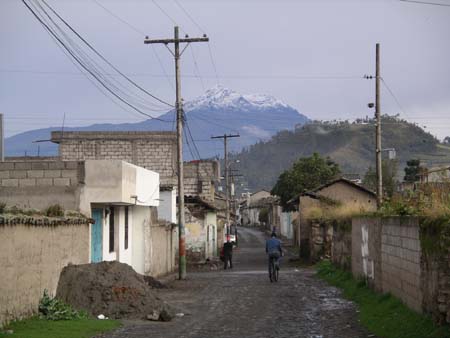
Paula: Heavy rains during the night gave way to clearer skies this morning and fantastic views of both the Cotacachi and Imbabura volcanoes. The rains had left snow atop both of these volcanoes which are over 15,000 feet. So after an early morning walk to look for birds and a good breakfast, we headed to the Cotacachi-Cayapas Ecological Reserve.
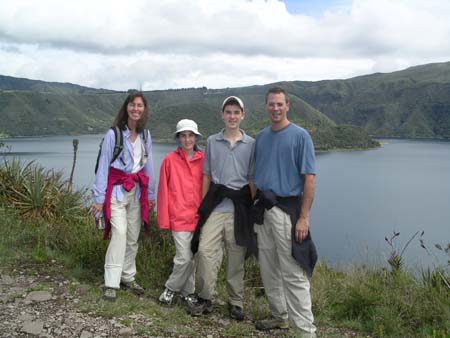 This
reserve is over 600,000 acres and incorporates three different ecosystems
- highlands, lowlands and a cloud forest. After driving to 10,700 feet we
found ourselves in front of the magnificent Lake Cotacachi. The lake was formed
thousands of years ago after the collapse of this volcano. Melting of the
glaziers originally filled the lake
This
reserve is over 600,000 acres and incorporates three different ecosystems
- highlands, lowlands and a cloud forest. After driving to 10,700 feet we
found ourselves in front of the magnificent Lake Cotacachi. The lake was formed
thousands of years ago after the collapse of this volcano. Melting of the
glaziers originally filled the lake 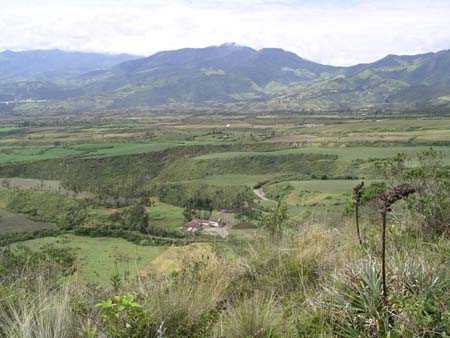 and
today snow from the surrounding volcanoes keeps the water fresh. David was
disappointed to discover that the lake has no fish and is classified as a
"dead lake" because of high levels sulfur in the water. The sulfur
is
and
today snow from the surrounding volcanoes keeps the water fresh. David was
disappointed to discover that the lake has no fish and is classified as a
"dead lake" because of high levels sulfur in the water. The sulfur
is 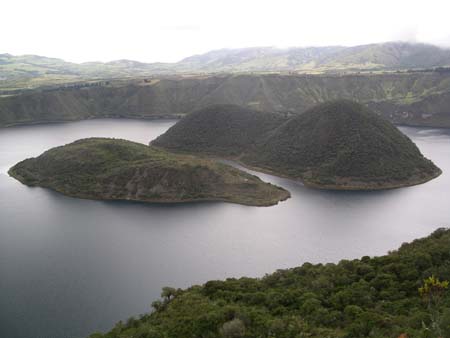 a
result of the old volcanic material as well as ongoing activity and residue
from the surrounding active volcanoes. In fact Henry told us that you can
actually see the water bubbling in the center of the lake if you go out on
a boat. He also told us that the lake is over 600 feet deep. We could even
see how lava that flowed from the volcano formed the valleys below.
a
result of the old volcanic material as well as ongoing activity and residue
from the surrounding active volcanoes. In fact Henry told us that you can
actually see the water bubbling in the center of the lake if you go out on
a boat. He also told us that the lake is over 600 feet deep. We could even
see how lava that flowed from the volcano formed the valleys below.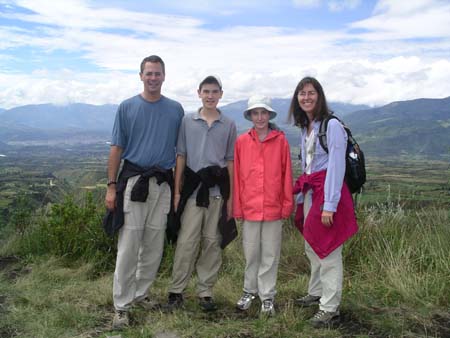
The purpose of the reserve is to protect the native plants and animals. Although
we didn't see any wildlife today, bear, monkeys, pumas, various cats, deer,
tapir and monkeys live here. We hiked for over two hours (about four miles)
in the reserve, first climbing in the highlands to 12,000 feet and then passing
down into the cloud forest. It was a beautiful hike with an almost continual
view of the 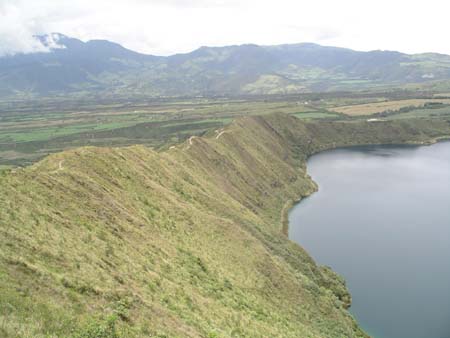 lake.
The vegetation initially was sparse and Henry showed us how many of the plants
that originally had come from the rain forest have adapted to survive the
harsher Andres climate. We also saw plants that are still used today by the
Indians as medical remedies.
lake.
The vegetation initially was sparse and Henry showed us how many of the plants
that originally had come from the rain forest have adapted to survive the
harsher Andres climate. We also saw plants that are still used today by the
Indians as medical remedies.
The hike was challenging because of the climb and altitude. We found 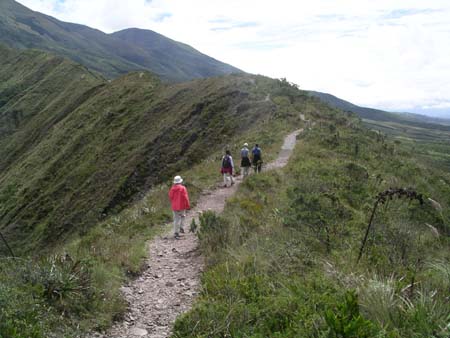 that
we had to stop frequently and were often out of breath. Once we reached 12,000
feet and began going down into the cloud forest, we were immediately aware
of an increase in humidity. The vegetation gradually became thick and at times
was so overgrown that we had to use our hands to navigate the trail. The wildflowers
were beautiful and of all colors.
that
we had to stop frequently and were often out of breath. Once we reached 12,000
feet and began going down into the cloud forest, we were immediately aware
of an increase in humidity. The vegetation gradually became thick and at times
was so overgrown that we had to use our hands to navigate the trail. The wildflowers
were beautiful and of all colors.
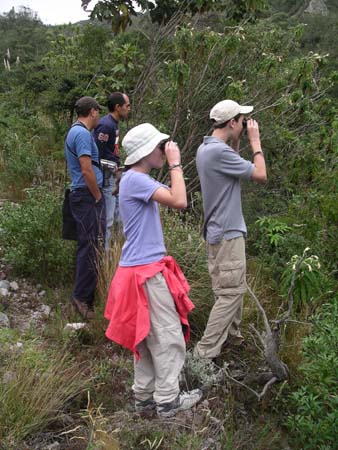 We
began to hear and see more birds as we entered the cloud forest and Henry
was anxious to help us view some of the area's colorful species. David first
spotted an American Kestrel, a member of the falcon family. It was hovering
over the hills looking for lizards.
We
began to hear and see more birds as we entered the cloud forest and Henry
was anxious to help us view some of the area's colorful species. David first
spotted an American Kestrel, a member of the falcon family. It was hovering
over the hills looking for lizards. 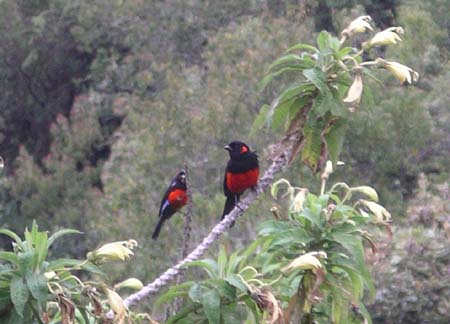
As we finished our hike, Henry heard the calls of several tanagers and also
a spinetail. We all marvel at Henry's ability to recognize the calls the many
birds here. Once he recognizes their call, he then plays that bird's calls
on his mini CD player with speakers. Amazingly, each and every time he enticed
not one but usually several of these species down from the trees so that we
were able to get a close view. We saw Azaras Spinetails, Southern Yellow Grosbecks
and Scarlet Breasted Mountain Tanagers. The tanagers were extra special as
a pair came particularly close enabling us to photograph them and to see their
beautiful red and blue ma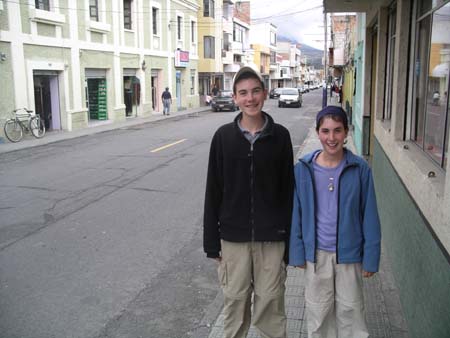 rkings.
At this rate, all of us (David and Katie included) will become birdwatchers.
Henry tells us that we have many more wonderful birds to see over the next
several days, since there are over 1,500 varieties in Ecuador.
rkings.
At this rate, all of us (David and Katie included) will become birdwatchers.
Henry tells us that we have many more wonderful birds to see over the next
several days, since there are over 1,500 varieties in Ecuador.
On the way back to the Hacienda, we enjoyed a traditional Ecuadorian lunch in a small village which specializes in the production of leather products. The meals here are quite large and lunch is the main meal of the day. We saw several families eating out and the children start school early here so that by 1:00PM they are done and can come home for lunch with their families. Soups are a stable in the diet here and we have enjoyed delicious homemade soup for every meal. Broccoli and avocado are grown locally and we have especially enjoyed these soups.
Late afternoon brought in the rain again. It was good to time back at the Hacienda reading, writing and playing games. Tomorrow we plan to visit Hacienda Zuletta where a special project is underway to protect the endangered Andean Condor.
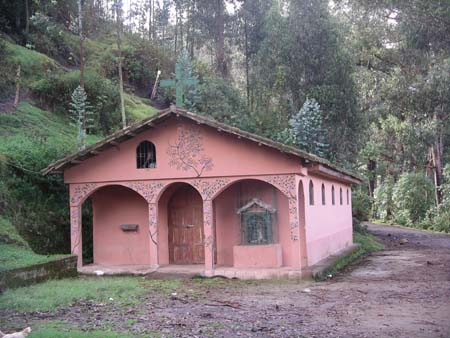
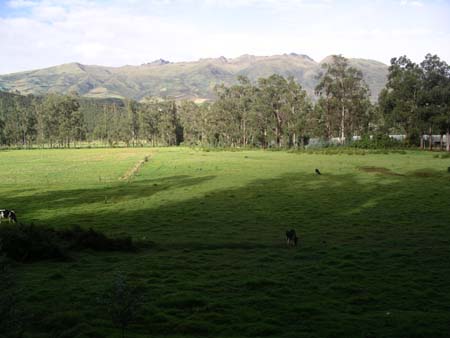
Katie's Kwick Kwacks: Our Experience with Bird Watching in The Andes Mountains.
Today we had our first experience with bird watching in South America. Before
we came here I didn't really like watching birds and found it to be pretty
boring. Now, however, I have become fascinated with the activity and its unique
process. 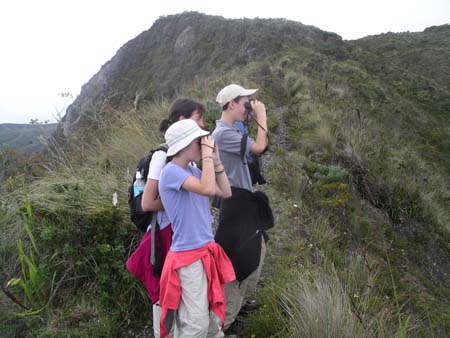
High up in the Andes Mountains, we began this procedure. Henry (our guide)
started his demonstration by listening to a bird's call, then identifying
it and looking it up in a guide book. What we found to be the most interesting
part of the demonstration, however, was when he took out a CD player and began
to play three different recordings of the bird's call. In a matter of seconds
we heard the identified bird respond, and before we knew it a beautiful Scarlet
Breasted Mountain Tanager flew over to the road and perched right in front
of 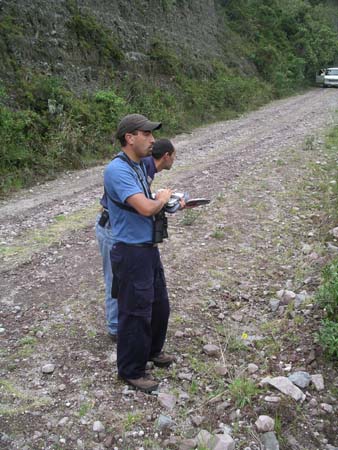 us.
We quickly pulled out our binoculars and tried to spot him before he hopped
over to a different plant. "I think they like call number three,"
Henry said to us excitedly. He began to play that particular recording a little
more often and sure enough the more he played it the more energetic and close
the bird came. After playing this call several times, we saw two more birds
join the first.
us.
We quickly pulled out our binoculars and tried to spot him before he hopped
over to a different plant. "I think they like call number three,"
Henry said to us excitedly. He began to play that particular recording a little
more often and sure enough the more he played it the more energetic and close
the bird came. After playing this call several times, we saw two more birds
join the first.
We found ourselves in the midst of a magical moment as we watched the three
birds chatter and hop around, their beautiful scarlet chests puffed out in
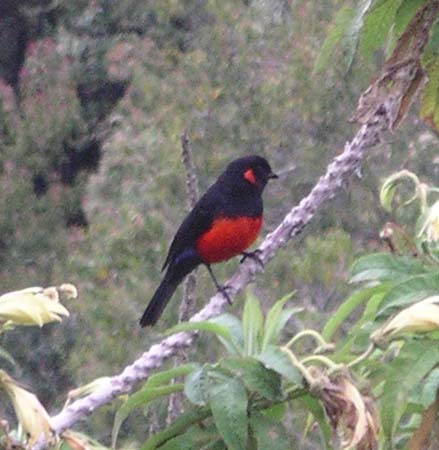 alertness. One of the birds eventually flew away, and we were left with a
male and female bird, singing and pecking at the small tree leaves. They stayed
very close to one another, looking for any sign of danger.
alertness. One of the birds eventually flew away, and we were left with a
male and female bird, singing and pecking at the small tree leaves. They stayed
very close to one another, looking for any sign of danger.
We later learned that these extraordinary actions were not only acts of curiosity, but also related to the birds' territorial instincts. When they hear the call of a bird they have never heard before, they want to check the newcomer out to see if it presents any kind of threat. When the birds react more to particular calls, this doesn't mean they like these better than the others but rather because they sound the most intimidating. We found their reactions to the CD recordings to be truly remarkable, and it was neat to have formed a little relationship with some of the Andes' fantastic birds.
Ecuador is the home of an astounding ten percent of the entire world's bird population. There are about 1,500 currently recorded types of birds here, and new species are frequently added to the list. After having such a pleasant experience with bird watching today, I am really looking forward to viewing more birds during our stay in this wonderful country.
David's Daily Dump: Lake Cotacachi. Once a massive volcano, Cotacachi
Lake has a magnificent history and an amazing story to tell. 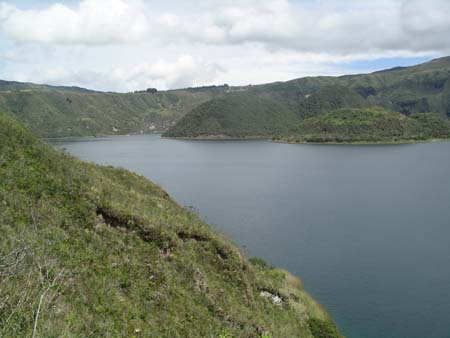
As we hiked around the beautiful lake, staring down at the two islands isolated in the middle of the sulfur water, it was almost impossible to imagine that this was once a volcano. Henry (our guide) told us that a big volcanic mountain once stood at the site of the lake, frequently erupting until its walls became too unstable and weak, which caused it to crash to the earth. The crash left a gargantuan crater behind and two small islands, which eventually got covered by a glacier. When the glacier melted, the Cotacachi Lake was formed.
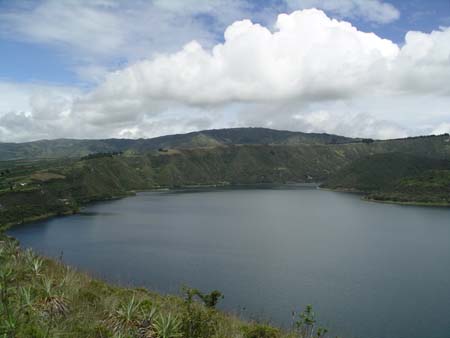 Today
the lake is actually still active, and bubbles can be seen reaching the surface
between the islands. A depth test was taken about 20 years back, showing that
the lake was over 600 ft deep! Actually that was only as far down as the equipment
could reach; the pressure was unbearable. Because the lake is connected underground
to the nearby Cotacachi volcano, the water is full of sulfur and cannot support
marine life. Trout were introduced to the lake many years ago and unfortunately
died instantly. I can't imagine what it would be like if this volcano became
active again…
Today
the lake is actually still active, and bubbles can be seen reaching the surface
between the islands. A depth test was taken about 20 years back, showing that
the lake was over 600 ft deep! Actually that was only as far down as the equipment
could reach; the pressure was unbearable. Because the lake is connected underground
to the nearby Cotacachi volcano, the water is full of sulfur and cannot support
marine life. Trout were introduced to the lake many years ago and unfortunately
died instantly. I can't imagine what it would be like if this volcano became
active again…
Seeing my first volcanic lake up close and personal was really cool. I found it really interesting to hike here, and look forward to exploring all the other active volcanoes in this area.
